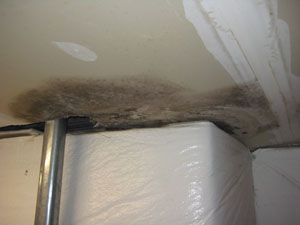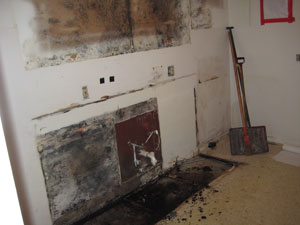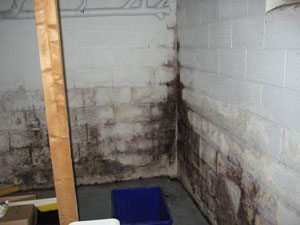 We have all heard of toxic black mold. The media has been sensationalizing stories about it in recent years. The truth is without mold we would be buried up to our eyeballs and beyond in dead decaying matter. Mold in the environment provides a useful means for breaking down biological matter in an environmentally sound manner. Without mold our compost piles would not decompose. While mold is not the only microorganism to be credited for making good compost it is the primary one that breaks down woody material. So in general, mold in our environment is a good thing.
We have all heard of toxic black mold. The media has been sensationalizing stories about it in recent years. The truth is without mold we would be buried up to our eyeballs and beyond in dead decaying matter. Mold in the environment provides a useful means for breaking down biological matter in an environmentally sound manner. Without mold our compost piles would not decompose. While mold is not the only microorganism to be credited for making good compost it is the primary one that breaks down woody material. So in general, mold in our environment is a good thing.
However, inside a building mold is not so good.
Inside a building mold spores can cause allergic reactions, illness and even death in highly susceptible people. The odors produced by mold can be irritating and in some cases toxic.
Pictured below is "Stachybotrys chartarum" also known as "black mold" or "toxic black mold," growing on dry-wall board.

Stachybotrys is frequently associated with poor indoor air quality that arises after fungal growth on water-damaged building materials.
Beware of Unqualified "Mold Specialists"
Anyone can claim to be a "Mold Expert". Mold removal is not regulated like asbestos removal. In most states, including New York State, anyone can claim to be "Mold Certified". In New York there are no state regulations that govern mold inspection or removal.
BEWARE - Some people take a short course on mold in buildings and immediatly go into business as "Certified Mold Specialists". Often they do not have the minimum credentials recognized by the American Industrial Hygiene Association (AIHA). ".

The American Industrial Hygiene Association is the premier environmental health and safety organization associated with safe mold management in buildings. AIHA publishes guidlines for mold management in buildings. AIHA guidelines are developed through a consensus process that involves review by internal AIHA technical committiees and external review by outside experts. AIHA has guidelines for exposure assessment, hazard assessment, removal, and re-occupancy post-remediation verification methodologies and techniques. The AIHA guidelines are currently accepted and available for use by "Competent Professionals".
According to AIHA a "Competent Professional" has at a minimum the following qualifications: Bachelor of Science in industrial hygiene, environmental health, or an engineering, life science, chemistry, or physics discipline; two years of experience under the direction of a Certified Industrial Hygienist (CIH) or Licensed Professional Engineer with significant experience in the following areas: Exposure Assessment, Indoor Environmental Quality (IEQ), Heating Ventilation and Air Conditioning (HVAC), Microbial assessment and remediation, building science, legal/communication, microbiology/mycology and health effects.
Before you hire a "Mold Specialist" ask for their credentials and don't be fooled by the "Short Course Expert".

CanAm Environmental Safety, Inc. has the "Competent Mold Professional" for any size job. We conduct assessments of mold contamination. We use assessment tools during inspections such as moisture meters and detection equipment, boroscopes, and wall cavity sampling devices. We may perform air sampling and analysis or collect bulk samples for analysis. Some of the sample methods we use include: air sample collection and analysis, contact samples, wipe and surface-wash samples, and micro-vac dust samples. Once our laboratory results are in we'll interpret the data and provide a report with recommendations and findings.
If remediation or removal is needed we may do the removal work ourselves. We often train custodial and maintenance staff in how to safety clean-up mold. We write the specifications for mold remediation. Our specifications are based on exposure control objectives, the extent of contamination, and site-specific logistics. In many cases we will perform post-remediation verification. A post-remediation verification procedure is included in many mold remediation projects to determine whether or not specified control objectives have been maintained and that the abatement area is acceptable for re-occupancy.

There are many factors that influence the potential for mold in buildings. The outdoor weather and building designs often contribute to mold inside buildings. Rain and moisture get into buildings through basement and foundation walls. Lack of maintenance, leaking appliances and failed pluming contribute to mold amplification. High humidity in attics and inside buildings give mold spores the moisture they need to grow and intensify. Once mold spores land on a damp surface it will grow. Drywall, wood framing, beneath wall paper, under carpets, and behind kitchen cabinets are great places for mold to grow and flourish.

You should not get mold on your skin or cloths. Do not disturb mold spores without proper training and equipment. Before you attempt to clean the problem consult a "Competent Professional" and read current clean-up guidelines, e.g., AIHA, EPA, Department of Health, and the American Conference of Governmental Hygienists (ACGIH). If you decide to remove the mold yourself get trained and buy the proper equipment before you start the work. At a minimum, you’ll need a high efficiency particulate air (HEPA) vacuum cleaner, a P-100 respirator that fits properly, disposable coveralls, plastic sheeting, scrubbers, and amended water. If you decide to remove the mold from your own home or business identify the magnitude of the problem, evaluate the hazard and use control procedures that the professionals use. Don’t put your family, workers or the community at risk.
Call CanAm Environmental Safety, Inc. for Comprehensive Mold Management Services Today!.....(585) 261-3205